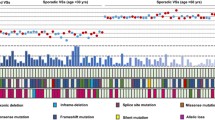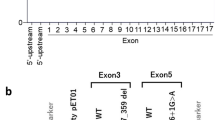Abstract
Purpose
Point mutations of TP53 tumour suppressor are very rare in schwannomas. We aim to characterize the frequency of exonic copy-number changes of the gene in the tumour and to examine the association between TP53 alterations, phosphorylation status of p53 protein and clinical phenotypes.
Methods
The alterations of TP53 were screened by a combination of Sanger sequencing and multiplex ligation-dependent probe amplification (MLPA) in a total of 44 vestibular schwannomas. The mutation index (MI) in a tumour was defined as the number of exons mutated/ the number of exons tested. Phosphorylation status of p53 protein was investigated by immunoblotting and immunofluorescence.
Results
MLPA analysis showed single and multi-exon deletion mutations of TP53 in 65.7% of the cases. Comparisons of clinical features between mutated and non-mutated patients established an association of TP53 mutations with progressive phenotypes, including an earlier formation and a larger tumour. In addition, there were significant correlations between MI and both patients’ age and tumour size. The Ser 392 phosphorylation level of p53 varied among tumours, and correlation analysis revealed an age-dependent phosphorylation pattern. The majority of tumours with hyperphosphorylated p53 were from mutated and young patients, suggesting an association of Ser392 phosphorylation with the mutational status of TP53 involved in the acceleration of tumour growth in young individuals. Moreover, Ser 392 phosphorylation contributed to a nuclear accumulation of p53 in schwannona cultures with TP53 mutation.
Conclusions
An interplay between the mutation status of TP53, phosphorylation patterns and tumour behaviors might be established in the disease.





Similar content being viewed by others
References
Zhu W, Chen H, Jia H, Chai Y, Yang J, Wang Z, Wu H (2018) Long-term hearing preservation outcomes for small vestibular schwannomas: retrosigmoid removal versus observation. Otol Neurotol 39(2):e158–e165. https://doi.org/10.1097/MAO.0000000000001684
Huang X, Caye-Thomasen P, Stangerup SE (2013) Spontaneous tumour shrinkage in 1261 observed patients with sporadic vestibular schwannoma. J Laryngol Otol 127(8):739–743. https://doi.org/10.1017/S0022215113001266
Chen H, Xue L, Wang H, Wang Z, Wu H (2017) Differential NF2 gene status in sporadic vestibular schwannomas and its prognostic impact on tumour growth patterns. Sci Rep 7(1):5470. https://doi.org/10.1038/s41598-017-05769-0
Chen H, Zhang X, Zhang Z, Yang T, Wang Z, Wu H (2014) The role of NF2 gene mutations and pathogenesis-related proteins in sporadic vestibular schwannomas in young individuals. Mol Cell Biochem 392(1–2):145–152. https://doi.org/10.1007/s11010-014-2011-9
Bull JG, Lipson AC, Martin AJ (2006) Giant vestibular schwannoma in a 12-year-old girl. Pediatr Neurosurg 42(5):338–340. https://doi.org/10.1159/000094076
Hadfield KD, Smith MJ, Urquhart JE, Wallace AJ, Bowers NL, King AT, Rutherford SA, Trump D, Newman WG, Evans DG (2010) Rates of loss of heterozygosity and mitotic recombination in NF2 schwannomas, sporadic vestibular schwannomas and schwannomatosis schwannomas. Oncogene 29(47):6216–6221. https://doi.org/10.1038/onc.2010.363
Bian LG, Tirakotai W, Sun QF, Zhao WG, Shen JK, Luo QZ (2005) Molecular genetics alterations and tumour behavior of sporadic vestibular schwannoma from the People’s Republic of China. J Neurooncol 73(3):253–260. https://doi.org/10.1007/s11060-004-5176-3
Lassaletta L, Torres-Martín M, Peña-Granero C, Roda JM, Santa-Cruz-Ruiz S, Castresana JS, Gavilan J, Rey JA (2013) NF2 genetic alterations in sporadic vestibular schwannomas: clinical implications. Otol Neurotol 34(7):1355–1361. https://doi.org/10.1097/MAO.0b013e318298ac79
Agnihotri S, Jalali S, Wilson MR, Danesh A, Li M, Klironomos G, Krieger JR, Mansouri A, Khan O, Mamatjan Y, Landon-Brace N, Tung T, Dowar M, Li T, Bruce JP, Burrell KE, Tonge PD, Alamsahebpour A, Krischek B, Agarwalla PK, Bi WL, Dunn IF, Beroukhim R, Fehlings MG, Bril V, Pagnotta SM, Iavarone A, Pugh TJ, Aldape KD, Zadeh G (2016) The genomic landscape of schwannoma. Nat Genet 48(11):1339–1348. https://doi.org/10.1038/ng.3688
Sakaguchi K, Sakamoto H, Lewis MS, Anderson CW, Erickson JW, Appella E, Xie D (1997) Phosphorylation of serine 392 stabilizes the tetramer formation of tumour suppressor protein p53. Biochemistry 36(33):10117–10124. https://doi.org/10.1021/bi970759w
Minamoto T, Buschmann T, Habelhah H, Matusevich E, Tahara H, Boerresen-Dale AL, Harris C, Sidransky D, Ronai Z (2001) Distinct pattern of p53 phosphorylation in human tumours. Oncogene 20(26):3341–3347. https://doi.org/10.1038/sj.onc.1204458
Gutmann DH, James CD, Poyhonen M, Louis DN, Ferner R, Guha A, Hariharan S, Viskochil D, Perry A (2003) Molecular analysis of astrocytomas presenting after age 10 in individuals with NF1. Neurology 61(10):1397–1400. https://doi.org/10.1212/WNL.61.10.1397
Gillet E, Alentorn A, Doukouré B, Mundwiller E, van Thuijl HF, Reijneveld JC, Medina JA, Liou A, Marie Y, Mokhtari K, Hoang-Xuan K, Sanson M, Delattre JY, Idbaih A (2014) TP53 and p53 statuses and their clinical impact in diffuse low grade gliomas. J Neurooncol 118(1):131–139. https://doi.org/10.1007/s11060-014-1407-4
Chen Y, Wang ZY, Wu H (2015) P14ARF deficiency and its correlation with overexpression of p53/ MDM2 in sporadic vestibular schwannomas. Eur Arch Otorhinolaryngol 272(9):2227–2234. https://doi.org/10.1007/s00405-014-3135-y
Monoh K, Ishikawa K, Yasui N, Mineura K, Andoh H, Togawa K (1998) p53 tumour suppressor gene in acoustic neuromas. Acta Otolaryngol Suppl 537:11–15. https://doi.org/10.1080/00016489850182288
Ohgaki H, Eibl RH, Schwab M, Reichel MB, Mariani L, Gehring M, Petersen I, Höll T, Wiestler OD, Kleihues P (1993) Mutations of the p53 tumour suppressor gene in neoplasms of the human nervous system. Mol Carcinog 8(2):74–80. https://doi.org/10.1002/mc.2940080203
Yanamadala V, Williamson RW, Fusco DJ, Eschbacher J, Weisskopf P, Porter RW (2013) Malignant transformation of a vestibular schwannoma after gamma knife radiosurgery. World Neurosurg 79(3–4):593. https://doi.org/10.1016/j.wneu.2012.03.016
Shlien A, Baskin B, Achatz MI, Stavropoulos DJ, Nichols KE, Hudgins L, Morel CF, Adam MP, Zhukova N, Rotin L, Novokmet A, Druker H, Shago M, Ray PN, Hainaut P, Malkin D (2010) A common molecular mechanism underlies two phenotypically distinct 17p13.1 microdeletion syndromes. Am J Hum Genet 87(5):631–642.https://doi.org/10.1016/j.ajhg.2010.10.007.
Mouchawar J, Korch C, Byers T, Pitts TM, Li E, McCredie MR, Giles GG, Hopper JL, Southey MC (2010) Population-based estimate of the contribution of TP53 mutations to subgroups of early-onset breast cancer: Australian Breast Cancer Family Study. Cancer Res 70(12):4795–4800. https://doi.org/10.1158/0008-5472.CAN-09-0851
Bazrafshani MR, Nowshadi PA, Shirian S, Daneshbod Y, Nabipour F, Mokhtari M, Hosseini F, Dehghan S, Saeedzadeh A, Mosayebi Z (2016) Deletion/duplication mutation screening of TP53 gene in patients with transitional cell carcinoma of urinary bladder using multiplex ligation-dependent probe amplification. Cancer Med 5(2):145–152. https://doi.org/10.1002/cam4.561
Dayalan AH, Jothi M, Keshava R, Thomas R, Gope ML, Doddaballapur SK, Somanna S, Praharaj SS, Ashwathnarayanarao CB, Gope R (2006) Age dependent phosphorylation and deregulation of p53 in human vestibular schwannomas. Mol Carcinog 45(1):38–46. https://doi.org/10.1002/mc.20150
Nakamura H, Jokura H, Takahashi K, Boku N, Akabane A, Yoshimoto T (2000) Serial follow-up MR imaging after gamma knife radiosurgery for vestibular schwannoma. AJNR Am J Neuroradiol 21(8):1540–1546
Matsumoto M, Furihata M, Ohtsuki Y (2006) Posttranslational phosphorylation of mutant p53 protein in tumor development. Med Mol Morphol 39(2):79–87. https://doi.org/10.1007/s00795-006-0320-0
Kim YY, Park BJ, Kim DJ, Kim WH, Kim S, Oh KS, Lim JY, Kim J, Park C, Park SI (2004) Modification of serine 392 is a critical event in the regulation of p53 nuclear export and stability. FEBS Lett 572(1–3):92–98. https://doi.org/10.1016/j.febslet.2004.07.014
Chen H, Xue L, Huang H, Wang H, Zhang X, Zhu W, Wang Z, Wang Z, Wu H (2018) Synergistic effect of Nutlin-3 combined with MG-132 on schwannoma cells through restoration of merlin and p53 tumour suppressors. EBioMedicine 36:252–265. https://doi.org/10.1016/j.ebiom.2018.09.042
Olivier M, Eeles R, Hollstein M, Khan MA, Harris CC, Hainaut P (2002) The IARC TP53 database: new online mutation analysis and recommendations to users. Human Mutat 19(6):607–614. https://doi.org/10.1002/humu.10081
Niederacher D, An HX, Camrath S, Dominik SI, Göhring UJ, Oertel A, Grass M, Hantschmann P, Lordnejad MR, Beckmann MW (1998) Loss of heterozygosity of BRCA1, TP53 and TCRD markers analysed in sporadic endometrial cancer. Eur J Cancer 34(11):1770–1776. https://doi.org/10.1016/S0959-8049(98)00270-6
Robanus-Maandag E, Giovannini M, van der Valk M, Niwa-Kawakita M, Abramowski V, Antonescu C, Thomas G, Berns A (2004) Synergy of Nf2 and p53 mutations in development of malignant tumours of neural crest origin. Oncogene 23(39):6541–6547. https://doi.org/10.1038/sj.onc.1207858
Chang Z, Guo CL, Ahronowitz I, Stemmer-Rachamimov AO, MacCollin M, Nunes FP (2009) A role for the p53 pathway in the pathology of meningiomas with NF2 loss. J Neurooncol 91(3):265–270. https://doi.org/10.1007/s11060-008-9721-3
Joerger AC, Fersht AR (2007) Structure-function-rescue: the diverse nature of common p53 cancer mutants. Oncogene 26(15):2226–2242. https://doi.org/10.1038/sj.onc.1210291
Junk DJ, Vrba L, Watts GS, Oshiro MM, Martinez JD, Futscher BW (2008) Different mutant/wild-type p53 combinations cause a spectrum of increased invasive potential in nonmalignant immortalized human mammary epithelial cells. Neoplasia 10(5):450–461. https://doi.org/10.1593/neo.08120
Furihata M, Kurabayashi A, Matsumoto M, Sonobe H, Ohtsuki Y, Terao N, Kuwahara M, Shuin T (2002) Frequent phosphorylation at serine 392 in over expressed p53 protein due to missense mutation in carcinoma of the urinary tract. J pathol 197(1):82–88. https://doi.org/10.1002/path.1082
Rohini K, Mathivanan J, Prabhu PD, Subbakrishna DK, Gope ML, Chandramouli BA, Sampath S, Anandh B, Gope R (2007) Loss of heterozygosity of the p53 gene and deregulated expression of its mRNA and protein in human brain tumours. Mol Cell Biochem 300(1–2):101–111. https://doi.org/10.1007/s11010-006-9374-5
Ammoun S, Schmid MC, Zhou L, Hilton DA, Barczyk M, Hanemann CO (2015) The p53/mouse double minute 2 homolog complex deregulation in merlin-deficient tumours. Mol Oncol 9(1):236–248. https://doi.org/10.1016/j.molonc.2014.08.005
Kim H, Kwak NJ, Lee JY, Choi BH, Lim Y, Ko YJ, Kim YH, Huh PW, Lee KH, Rha HK, Wang YP (2004) Merlin neutralizes the inhibitory effect of Mdm2 on p53. J Biol Chem 279(9):7812–7818. https://doi.org/10.1074/jbc.M305526200
Acknowledgements
This research was funded by the National Natural Science Foundation of China (Grant No. 81800898 to Hongsai Chen, No. 81670919 and No. 81870713 to Zhaoyan Wang, No. 81570906 to Hao Wu, No. 81700900 to Weidong Zhu and No. 81600815 to Yongchuan Chai).
Author information
Authors and Affiliations
Corresponding authors
Ethics declarations
Conflict of interest
The authors declare that they have no competing interests.
Additional information
Publisher's Note
Springer Nature remains neutral with regard to jurisdictional claims in published maps and institutional affiliations.
Electronic supplementary material
Below is the link to the electronic supplementary material.
Rights and permissions
About this article
Cite this article
Chen, H., Huang, H., Zhao, J. et al. Age-dependent copy number variations of TP53 tumour suppressor gene associated with altered phosphorylation status of p53 protein in sporadic schwannomas. J Neurooncol 143, 369–379 (2019). https://doi.org/10.1007/s11060-019-03176-1
Received:
Accepted:
Published:
Issue Date:
DOI: https://doi.org/10.1007/s11060-019-03176-1




